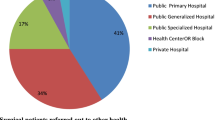Abstract
Background
The need for surgical care far exceeds available facilities, especially in low income and poor countries. Limited data are available to help us understand the extent and nature of barriers that limit access to surgical care, particularly in the Asian subcontinent. The aim of this study was to understand factors that influence access to surgical care in a low-income urban population.
Methods
An observational cross-sectional study was conducted on 199 consecutive patients admitted for elective surgery from February to April 2010 to identify the presence and causes of delay in accessing surgical care.
Results
The median duration of symptoms were 7 and 4 months in women and men, respectively. The odds of delay between the onset of symptoms and seeking initial health care (first interval) is twice as likely for women than for men [52.7 vs. 37.5 %, odds ratio (OR) 1.9]. Lack of knowledge regarding treatment options [OR 3.8; 95 % confidence interval (CI) 1.4–10.3] and about disease implications (OR 2.4; 95 % CI 1.2–4.8) were cited most often. A second interval of delay (time from when surgery was first advised to the surgery) was reported by 123 (61.8 %) patients. Financial constraints (29.6 %) and environment-related delays (10.6 %) were cited most often. More women than men thought there was a second delay interval (73 vs. 58 %). The odds of women having more co-morbid conditions were nearly 4.7 times that of men (95 % CI 1.5–15.1).
Conclusions
A complex interaction of factors limits access to surgical care in developing countries. Women appear to face greater hurdles to accessing health care. Understanding local factors is essential to make care accessible.
Similar content being viewed by others
References
Mathers C, Fat DM, Boerma JT et al (2008) The global burden of disease: 2004 update, vol vii. World Health Organization, Geneva, p 146
Lopez AD, Mathers CD, Ezzati M et al (2006) Global and regional burden of disease and risk factors, 2001: systematic analysis of population health data. Lancet 367:1747–1757
Spiegel DA, Gosselin RA (2007) Surgical services in low-income and middle-income countries. Lancet 370:1013–1015
Ozgediz D, Jamison D, Cherian M et al (2008) The burden of surgical conditions and access to surgical care in low- and middle-in come countries. Bull World Health Organ 86:646–647
Anonymous (2008) Pakistan demographic health Survey 2006–07. National Institute of Population Studies and Macro International Inc., Islamabad
Ahmed M, Shah M, Luby S et al (1999) Survey of surgical emergencies in a rural population in the northern areas of Pakistan. Trop Med Int Health 4:846–857
Blanchard RJ, Blanchard ME, Toussignant P et al (1987) The epidemiology and spectrum of surgical care in district hospitals of Pakistan. Am J Public Health 77:1439–1445
Zafar SN, McQueen KA (2011) Surgery, public health, and Pakistan. World J Surg 35:2625–2634. doi:10.1007/s00268-011-1304-3
Ryoo JJ, Ko CY (2008) Minimizing disparities in surgical care: a research focus for the future. World J Surg 32:516–521. doi:10.1007/s00268-007-9421-8
UNDP (2007) Human development report 2007/2008. United Nations Development Programme, New York
Forstall RL, Greene RP, Pick JB (2009) Which are the largest? Why lists of major urban areas vary so greatly. Tijdschr Econ Soc Geogr 100:277–297
Population Division of the Department of Economic and Social Affairs of the United Nations Secretariat (2008) World population prospects, the 2006 revision and world urbanization prospects: 2007 revision. New York
Barnes-Josiah D, Myntti C, Augustin A (1998) The “three delays” as a framework for examining maternal mortality in Haiti. Soc Sci Med 46:981–993
Center APaHR (2002) Population and health dynamics in Nairobi’s informal settlements. African Population and Health Research Center, Nairobi
Ivers LC, Garfein ES, Augustin J et al (2008) Increasing access to surgical services for the poor in rural Haiti: surgery as a public good for public health. World J Surg 32:537–542. doi:10.1007/s00268-008-9527-7
Bigby J, Ashley SW (2008) Disparities in surgical care: strategies for enhancing provider-patient communication. World J Surg 32:529–532. doi:10.1007/s00268-007-9386-7
Rogers SO Jr (2008) Disparities in surgery: access to outcomes. World J Surg 32:505–508. doi:10.1007/s00268-007-9382-y
Anonymous (2005) Pakistan, country gender assessment 2005. World Bank, Islamabad
Khan A (1999) Mobility of women and access to health and family planning services in Pakistan. Reprod Health Matters 7:39–48
Ensor T, Cooper S (2004) Overcoming barriers to health service access: influencing the demand side. Health Policy Plan 19:69–79
Khan FS, Lotia-Farrukh I, Khan AJ et al (2013) The burden of non-communicable disease in transition communities in an Asian megacity: baseline findings from a cohort study in Karachi, Pakistan. PloS One 8:e56008
Marsh D, Hashim R, Hassany F et al (1996) Front-line management of pulmonary tuberculosis: an analysis of tuberculosis and treatment practices in urban Sindh, Pakistan. Tuber Lung Dis 77:86–92
Grossman J (1990) Health education: the leading edge of primary health care and maternal and child health. In: Wallace HM, Giri K (eds) Health care of women and children in developing countries. Third Party Publishing, Oakdale, pp 56–57
Bellagio Essential Surgery Group (2007) Conference: increasing access to surgical services in resource-constrained settings in Sub-Saharan Africa. New York, Rockefeller Foundation’s Bellagio Conference Center
WHO (2007) WHO meeting on global initiative for emergency and essential surgical care (GIEESC). Health Technology and Pharmaceuticals Cluster. World Health Organization, Dar-es-Salaam
Acknowledgments
The authors acknowledge the contribution of Sundus Iftikhar, who analyzed the data. The authors are grateful for all of the support provided by Indus Hospital and Interactive Research and Development.
Conflict of interest
None.
Author information
Authors and Affiliations
Corresponding author
Rights and permissions
About this article
Cite this article
Samad, L., Jawed, F., Sajun, S.Z. et al. Barriers to Accessing Surgical Care: A Cross-Sectional Survey Conducted at a Tertiary Care Hospital in Karachi, Pakistan. World J Surg 37, 2313–2321 (2013). https://doi.org/10.1007/s00268-013-2129-z
Published:
Issue Date:
DOI: https://doi.org/10.1007/s00268-013-2129-z




